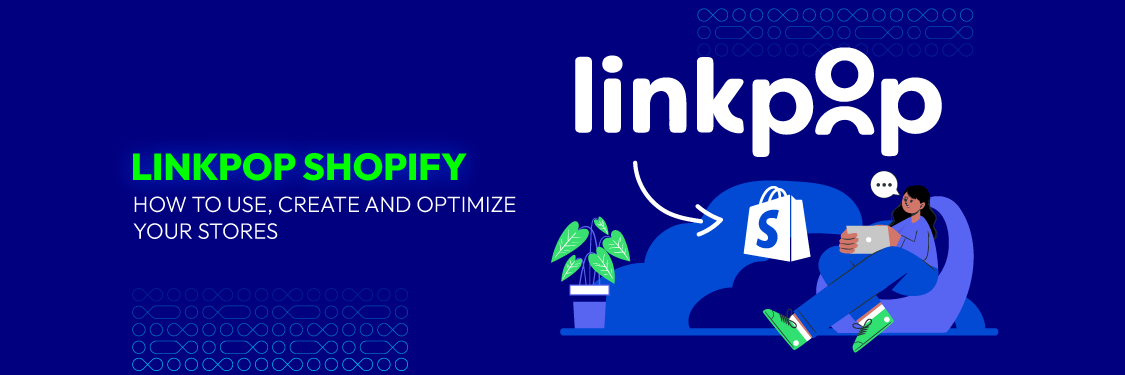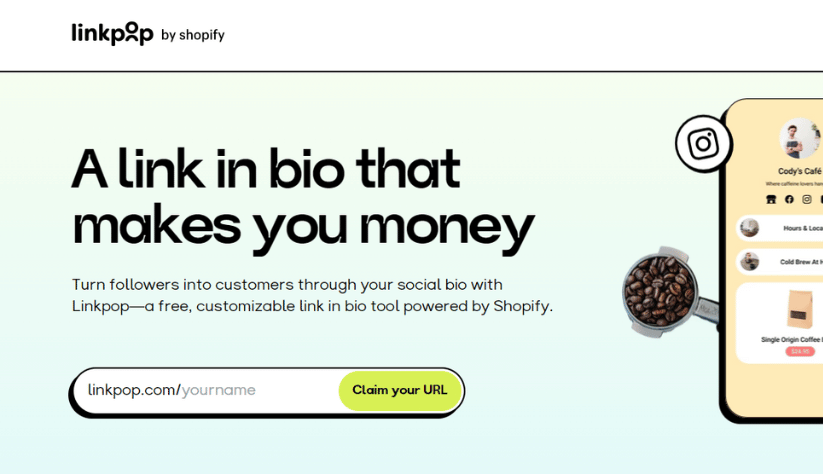Linkpop Shopify: How to Use, Create and Optimize Your Stores
Summer Nguyen | 01-24-2024

Link in bio is currently widely used by many young people, businesses, and online sellers on social networking or e-commerce platforms. This is a way to help users grasp useful personal information when accessing their page and help customers easily shop online.
Along with technology development, many tools to help create links appear, notably Linktree or LnkBio. Shopify also launched Linkpop to support this feature. So, what is Linkpop Shopify? What are its uses? How to use it? Let’s check this article now!
What is Linkpop by Shopify?
Linkpop, created by Shopify, is a free tool that allows you to create a landing page specifically designed to be accessed through social media. This landing page can be used for a couple of purposes:
- Showcase products and sell them directly: You can include links to your products on your Linkpop page, and customers can purchase those products directly from the landing page. Linkpop integrates with Shopify’s checkout system, so customers can complete their purchases in just a few clicks.
- Provide a hub for all your online content: Linkpop allows you to include links to your social media profiles, your online store, other websites you might have, or even media like videos and music playlists. This gives your customers a central location to find everything related to your business.

Conditions for using Linkpop Shopify
Conditions for using Linkpop Shopify are very simple. You don’t need to be a Shopify store owner to enable Linkpop’s functionalities.
Linkpop allows anyone to sign up for a free trial with no expiration date. In addition, Shopify also supports the process of users registering for the Linkpop experience so that all operations will become more convenient.
Many people still mistakenly believe that using Linkpop means creating a store on the Shopify ecommerce platform. This is completely incorrect because the account you register is only used to access Linkpop features.
However, users need to register for a Shopify account if they want to use the Shoppable link function. You can use the free trial package for about 30 days, then sign up for the service for a better experience. According to the latest information, users only pay about $5 monthly to activate their account.

How does Linkpop Shopify work?
Linkpop will be a support tool to help customers shop more conveniently on the Shopify site. Specifically, they can view products on the profile page and shop simultaneously because the links in Linkpop will lead them to the product purchase page directly. This will help customers reduce complex shopping operations while increasing conversion rates for Shopify stores.
Each account can use up to 200 links for your Shopify online store. So, you can freely share Linkpop links with your customers or on social media platforms.

With Linkpop Shopify, the customer payment process becomes faster and more convenient. They only need a few clicks and can easily access data such as the number of clicks on each link or the number of visits to that sales page.
If you don’t have a Shopify store, you can also use Linkpop. This tool only requires a Shopify account to control links and customize product links for customers. You can then create links pointing to the Linkpop site or add them to your social media accounts. You can use a single link or change them frequently according to different topics.
In addition, Linkpop also acts as a data analysis site for store owners to observe and track customer reviews. Through this analysis, they will know where they are doing well and how to improve to achieve better business performance. The most basic data on Linkpop you can easily observe is the number of link clicks and users accessing it.
5 steps to create a free link in the bio page with Linkpop
To create a free link in the bio page with Linkpop, you must visit Linkpop’s homepage first. Then, log in to your Shopify account and connect to your Linkpop account. Below are the specific steps immediately following.
Step 1: Set up your profile
- Visit https://www.linkpop.com/en/ and choose a unique URL for your Linkpop page (like linkpop.com/yourname. This can’t be changed later, so keep it simple and memorable (e.g., your store name).
- Upload a profile picture (ideally your store logo) and write a short description.
- You can also add a cover photo and customize the theme colors and fonts to match your brand.
- Click “Publish” to save your changes.

Once you have completed the profile creation step, you’ll be redirected to another page to connect your Shopify store. Specifically, you can add links to other websites and images, music, or videos to make the website more lively.
You can customize the Linkpop Shopify theme by changing the fonts or colors to suit your store. After each adjustment, you can see a preview on the website, and remember to press the Publish button to save the changes.
Step 2: Add your social channels
- Go to the “Bio” tab and link your social media accounts (e.g., Instagram, TikTok, Facebook) by clicking the icons and entering your profile URLs. This helps customers find you on other platforms.
- You can also add links to other websites or content you want to showcase.

Step 3: Add your store link
- Go to the “Bio” tab and link your social media accounts (e.g., Instagram, TikTok, Facebook) by clicking the icons and entering your profile URLs. This helps customers find you on other platforms.
- You can also add links to other websites or content you want to showcase.

Step 4: Add your product link
You can provide information for each product in your product catalog on your Shopify store. You should not add all the information but only highlight information such as the seller’s name, products promoted on social network accounts, or a new product just launched.
In the bio or profile editing section, there should be a field where you can enter text. Paste the product link in this field. Some platforms may have specific sections for links labeled as “Website,” “URL,” or something similar.
You should add a brief description or call-to-action along with the link. Linkpop allows you to format your bio using basic text formatting options. Once you have added the product link and any additional information, look for a “Save” or “Update” button and click on it to save your changes.
Step 5: Add productive
Usually, sellers only add links to product information or add links to lead directly to the shopping page. However, you can be more creative with Linkpop. For example, you can add links to the following sections to improve productivity and customer satisfaction.
- Customer review: Including a link to customer reviews allows potential customers to see the real experiences of others, building trust and credibility in your brand. When potential customers realize that others have positive experiences, they’re more likely to trust your product and make a purchase. When using links to customer reviews, it’s essential to ensure that the reviews are easily accessible, genuine, and reflect diverse experiences. Additionally, be transparent about the source of the reviews to maintain trust with your audience.
- Blog post: Relevant links within your blog posts can provide additional information, context, or resources, enhancing the overall experience for your readers. It’s important to strike a balance when adding links to your blog posts. Ensure that links are relevant, add value to your content, and are not overused.
- Your retail location: It is important to note that the success of retail locations depends on various factors, including the industry, target market, and overall business strategy. Businesses should consider the benefits and challenges of maintaining physical storefronts to align with their goals and customer expectations.
- Your business’s story: Storytelling connects with your audience, helping them understand the personality and ethos of your brand. Use multimedia elements, like images or videos, to enhance the storytelling experience and capture your audience’s attention.
- Your contact information: Including a link to your contact information makes it easy for visitors to reach out to your Shopify store. Ensure that your contact information is kept up-to-date, and regularly test the links to ensure they function correctly. A user-friendly and easily accessible contact page is an important aspect of a well-designed website.
- Marketplace you sell on: Offering links to marketplaces provides convenience for customers who prefer to shop on specific platforms. It simplifies purchasing for those already familiar and comfortable with particular marketplaces.
Tips to optimize Linkpop Shopify
Optimizing Linkpop Shopify is crucial for driving traffic, engaging your audience, and achieving your online goals. Whether you are using a social media platform’s native link options, a third-party link management tool, or a dedicated page on your website, here are some tips to help you optimize your Linkpop:
- Use a link management tool: A link management tool like Linktree or Bio. FM or other similar services allow you to create a single, customizable landing page housing multiple links. Then, choose a tool that provides analytics to track link clicks, helping you understand the performance of your links.
- Prioritize key links: Feature your most important links at the top of the Linkpop page. Whether it is your latest blog post, a product launch, or a special promotion, make sure the most relevant content is easily accessible.
- Regularly update your links: Keep your Linkpop updated with fresh content and regularly swap out links to highlight new blog posts, products, or events. This encourages your audience to check back often.
- Create clear call-to-actions (CTAs): Use compelling and concise language in your link descriptions. Communicate what users will find when they click on a specific link and use action-oriented language to encourage engagement.
- Utilize multimedia: Incorporate images or icons alongside your links to make your Linkpop page visually appealing and to provide users with a quick preview of the content they will find.
- Promote campaigns and special offers: If you run a promotion, contest, or special offer, feature it prominently in your Linkpop. Make sure users can easily access details and participate.
- Customize the Linkpop page: If you can customize the appearance of your Linkpop page, align it with your brand’s aesthetics. Use colors, fonts, and images matching your overall branding.
- Link to your website or blog: If your Linkpop page allows for a direct link to your website or blog, make sure it is prominently featured. This is particularly useful for driving traffic to your core online presence.
- Test different strategies: Experiment with combinations of links and arrangements to see what works best for your audience. Use A/B testing, if available, to compare the performance of different link setups.
- Engage audience: Encourage your followers to visit your Linkpop page by mentioning it in captions, stories, or posts. Consider running contests or promotions that require users to visit your page.
Remember to regularly assess the performance of your LinkedIn page through analytics and adjust your strategy based on what resonates most with your audience. Keep in mind that user preferences and behaviors can evolve, so staying adaptable is key.
Why should we use Linkpop Shopify?
Using Linkpop Shopify is popular on social media platforms, especially for individuals and businesses looking to direct their audience to specific content or web pages. Here are some reasons why using this tool can be beneficial:
- Limited links on social media profiles: Most social media networks limit the amount of clickable links that can be included in a post. Instagram, for example, allows only one clickable link in the bio. You can direct your audience to a central spot where they can find several connections to diverse materials or goods by using Linkpop.
- Promotion and marketing: If you are running a marketing campaign, introducing a new product, or promoting specific content on Shopify, Linkpop allows you to send your followers to the appropriate landing page. This simplifies your promotional activities and improves the user experience.
- Increased traffic to your website: You may increase traffic to your website or other platforms by utilizing Linkpop. This is especially critical for businesses that want to convert their social media following into website visitors and potential clients.
- Flexibility and updates: You can update the URL in your bio as often as you like. This adaptability is important for dynamic content strategies like advertising different products, blog entries, or events at other times.
- Centralized content hub: Linkpop is a central location for your audience to explore different areas of your internet presence. Links to your website, blog, online store, promotional activities, or other important content might be included.
- Analytics and tracking: Some platforms and third-party services provide analytics and tracking features for the links you include in your bio. This allows you to measure the effectiveness of your social media efforts and understand which links are generating the most engagement and clicks.
- Cross-promotion: Linkpop can be useful for cross-promotion if you are active on many social media networks. Users from one platform can be directed to specific content or promotions on another.

FAQs
Can I view my link in bioanalytics with Linkpop?
Absolutely yes. Linkpop Shopify will allow users to track the linking site’s analytics and performance. Specifically, you will track the number of customers accessing the link and the number of clicks. Through these analytical data, users will evaluate which products customers trust and improve the bad points.
Is Linkpop free?
According to Shopify’s policy, Linkpop is a free tool for all users. However, to use this tool, you must have a Shopify account. Shopify only allows new users to experience 1 month of this application for free for one month. After that period, you need to sign up for different packages to start selling on this platform. Now, you need to create links for products and share them on Linkpop to attract customers.
You can also visit Linkpop’s official website or look for information on app marketplaces or directories where the tool might be listed to find pricing details, including whether a free plan or trial is available.
Conclusion
Linkpop Shopify is a tool that helps you collect data quickly, enrich your list of potential customers, and manage traffic. This is valuable data that allows effective marketing activities and customer insight. This data lets you make appropriate plans and strategies for marketing activities and improve efficiency.







![Top 20+ Must-have Shopify Apps for 2025 [Free & Paid] - Mageplaza](https://cdn2.mageplaza.com/media/blog/must-have-shopify-apps/top-must-have-shopify-apps.png)
![[2025 Updates] Top 10+ Upsell Apps for Shopify - Mageplaza](https://cdn2.mageplaza.com/media/blog/best-upsell-shopify-app/cover.png)